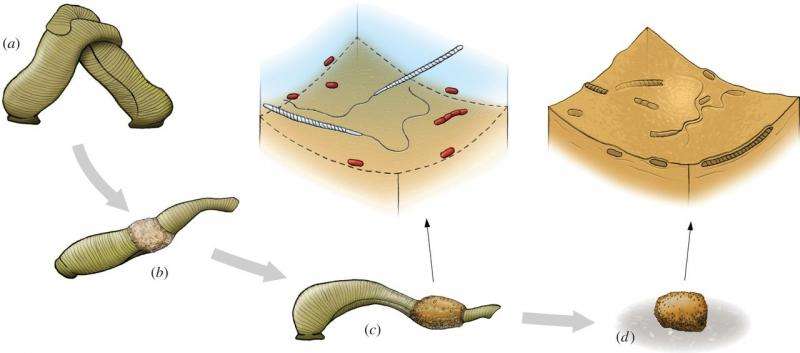July 15, 2015 report
50 million year old sperm cells found in fossilized cocoon

(Phys.org)—A small team of researchers with members from institutions in Sweden, Argentina and Italy, has discovered fossilized sperm cells embedded in the walls of an ancient cocoon. In their paper published in the journal Biology Letters, the group describes how they came across the sperm fossils while studying a 50 million year old cocoon found on Seymour Island in Antarctica.
It is very rare to find fossilized examples of sperm cells because they are soft-bodied—they have no bones. Prior examples have mostly been found in amber. The fossils found by the researchers in this new effort were discovered by accident—the researchers were merely studying the intricacies of a fossilized worm, or leech (of the class Clitellata) cocoon they had found on the island to learn more about the creature that left it behind. In making their cocoon, the ancient worm would have applied jelly-like material to the walls, which would remain in that state for just a couple of days—sperm would have been deposited inside as a means of fertilization, and in a few cases become embedded in the cocoon wall, where it then became fossilized after the walls hardened.
The fossilized sperm cells are tiny of course, just 60 micrometers long and resemble those of modern crayfish worms, the team reports, which is odd, because modern crayfish worms live only in the northern hemisphere. They have elongated head areas, a central region that holds the nucleus and extremely long tails. Dating has placed the age of the cocoon and its contents at 50 million years, which means the discovery is the oldest sperm cells ever found, by a margin of 10 million years.
After hearing reports of nematodes being trapped in some other ancient cocoons, the team was encouraged to look closer at the specimen they had found—they used an electron scanning microscope to examine the walls of the cocoon and found multiple sperm cells, though the team notes, the fossils are not actual cells—there is no organic material there—instead they are impressions left by the cells which long ago deteriorated. To gain a better perspective of their find, they created 3D models. They also note that it is likely other such specimens exist in already found cocoons but have not yet been discovered because researchers have not looked close enough.
More information: Fossilized spermatozoa preserved in a 50-Myr-old annelid cocoon from Antarctica, Biology Letters, DOI: 10.1098/rsbl.2015.0431
Abstract
The origin and evolution of clitellate annelids—earthworms, leeches and their relatives—is poorly understood, partly because body fossils of these delicate organisms are exceedingly rare. The distinctive egg cases (cocoons) of Clitellata, however, are relatively common in the fossil record, although their potential for phylogenetic studies has remained largely unexplored. Here, we report the remarkable discovery of fossilized spermatozoa preserved within the secreted wall layers of a 50-Myr-old clitellate cocoon from Antarctica, representing the oldest fossil animal sperm yet known. Sperm characters are highly informative for the classification of extant Annelida. The Antarctic fossil spermatozoa have several features that point to affinities with the peculiar, leech-like 'crayfish worms' (Branchiobdellida). We anticipate that systematic surveys of cocoon fossils coupled with advances in non-destructive analytical methods may open a new window into the evolution of minute, soft-bodied life forms that are otherwise only rarely observed in the fossil record.
Journal information: Biology Letters
© 2015 Phys.org



















